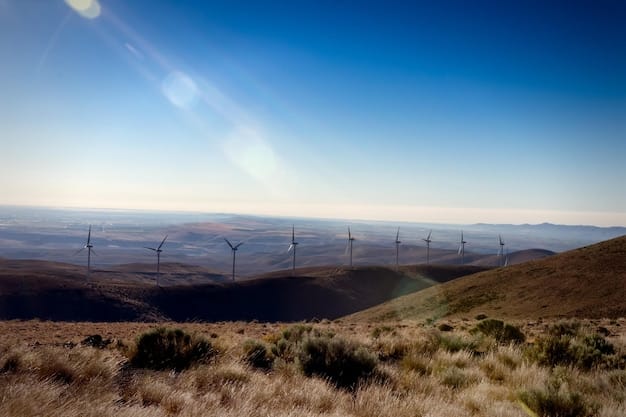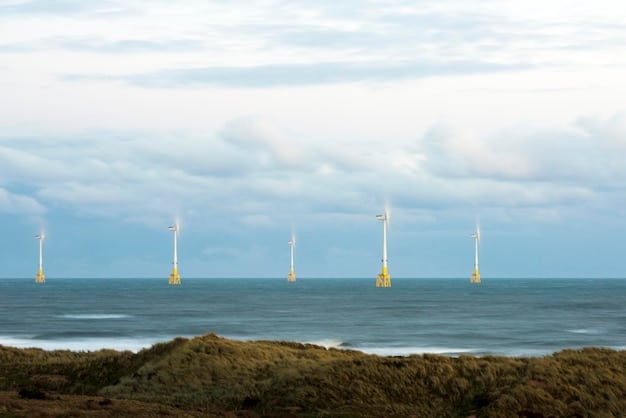US Government’s $5B Renewable Energy Investment: Sector Impact

The US government’s investment of $5 billion in renewable energy technologies marks a significant move, poised to accelerate innovation, create jobs, and drive the transition towards a sustainable energy future, impacting the green tech sector substantially.
The US government invests $5 billion in renewable energy tech: what this means for the green tech sector? This substantial financial commitment signals a pivotal moment, sparking both excitement and scrutiny within the rapidly evolving landscape of green technology.
Understanding the US Government’s Renewable Energy Investment
The Biden administration has recently announced a massive $5 billion investment aimed at bolstering renewable energy technologies. This initiative is not just about allocating funds; it’s a strategic move to accelerate the adoption of clean energy sources and address climate change.
This investment targets various sectors within the renewable energy landscape, including solar, wind, hydro, and geothermal. It also focuses on crucial areas like energy storage and grid modernization, recognizing that a comprehensive approach is necessary for a sustainable energy future.

Key Areas of Investment
The $5 billion will be distributed across several key areas to maximize its impact:
- Solar Energy: Funding research and development for more efficient and cost-effective solar panels.
- Wind Energy: Supporting offshore wind projects and improving wind turbine technology.
- Energy Storage: Investing in battery technology and other energy storage solutions to address intermittency issues.
- Grid Modernization: Upgrading the nation’s power grid to better integrate renewable energy sources.
This comprehensive investment strategy aims to tackle the multifaceted challenges associated with transitioning to a renewable energy-based economy.
In summary, the US government’s $5 billion investment is a significant step towards promoting renewable energy, addressing climate change, and creating a sustainable energy future. By targeting key areas like solar, wind, energy storage, and grid modernization, the initiative aims to accelerate the adoption of clean energy sources and drive innovation in the green tech sector.
The Impact on Solar Energy Technology
The solar energy sector is poised to receive a significant boost from the government’s investment. Solar technology has already made remarkable strides in recent years, but further advancements are crucial to make solar energy a more viable and competitive option.
With increased funding, research and development efforts can focus on improving the efficiency, durability, and affordability of solar panels. This could lead to breakthroughs in materials science, manufacturing processes, and energy conversion techniques.
Advancements in Solar Panel Technology
The investment will drive innovation in several key areas:
- Perovskite Solar Cells: Exploring the potential of perovskite materials to create high-efficiency solar cells.
- Bifacial Solar Panels: Enhancing the performance of bifacial solar panels, which can generate electricity from both sides.
- Thin-Film Solar Cells: Developing thin-film solar cells that are lighter, more flexible, and easier to install.
- Concentrated Solar Power (CSP): Improving CSP technology, which uses mirrors to focus sunlight and generate heat for electricity production.
These advancements could revolutionize the solar energy industry, making it more accessible and efficient for consumers and businesses alike.
In conclusion, the government’s investment will accelerate innovation in solar energy technology, leading to more efficient, durable, and affordable solar panels. This will make solar energy a more viable and competitive option, contributing to a cleaner and more sustainable energy future.
Wind Energy: Pushing the Boundaries of Innovation
Wind energy is another major beneficiary of the government’s renewable energy investment. With its vast wind resources, the US has the potential to become a global leader in wind energy production.
The investment will focus on advancing wind turbine technology, supporting offshore wind projects, and improving the integration of wind energy into the power grid. This will help to unlock the full potential of wind energy as a clean and reliable source of electricity.
Offshore Wind Development
Offshore wind projects are expected to receive a significant portion of the funding:
- Leasing and Permitting: Streamlining the leasing and permitting process for offshore wind farms.
- Infrastructure Development: Investing in port infrastructure to support the construction and maintenance of offshore wind turbines.
- Research and Development: Supporting research into floating wind turbine technology, which can be deployed in deeper waters.
- Workforce Training: Providing training programs to develop a skilled workforce for the offshore wind industry.
These initiatives will help to accelerate the development of offshore wind energy, creating jobs and reducing carbon emissions.

In summary, the government’s investment will drive innovation and development in the wind energy sector, particularly in offshore wind. By streamlining the leasing and permitting process, investing in infrastructure, supporting research, and providing workforce training, the initiatives will help unlock the full potential of wind energy as a clean and reliable source of electricity, creating jobs and reducing carbon emissions.
Energy Storage Solutions: Addressing Intermittency Challenges
One of the biggest challenges facing renewable energy sources like solar and wind is their intermittency. Energy storage solutions are crucial for addressing this challenge and ensuring a reliable supply of electricity.
The government’s investment will support the development and deployment of various energy storage technologies, including batteries, pumped hydro storage, and thermal energy storage. This will help to improve the stability and resilience of the power grid.
Types of Energy Storage Technologies
The investment will support several types of energy storage technologies:
- Lithium-Ion Batteries: Developing advanced lithium-ion batteries with higher energy density, longer lifespan, and improved safety.
- Flow Batteries: Investing in flow battery technology, which offers scalability and long-duration storage capabilities.
- Pumped Hydro Storage: Supporting the development of new pumped hydro storage projects, which can store large amounts of energy by pumping water uphill.
- Thermal Energy Storage: Developing thermal energy storage systems that can store heat or cold for later use.
These technologies will play a critical role in integrating renewable energy sources into the grid and ensuring a reliable supply of electricity.
In conclusion, the government’s investment in energy storage solutions is essential for addressing the intermittency challenges associated with renewable energy sources. By supporting the development and deployment of various energy storage technologies like batteries, pumped hydro storage, and thermal energy storage, the initiatives will improve the stability and resilience of the power grid, ensuring a reliable supply of electricity.
Modernizing the Power Grid for Renewable Integration
A modern and resilient power grid is essential for integrating renewable energy sources into the electricity system. The current grid infrastructure is often outdated and unable to handle the variable output of solar and wind power.
The government’s investment will support grid modernization efforts, including upgrading transmission lines, deploying smart grid technologies, and improving grid management systems. This will help to ensure that renewable energy can be reliably delivered to consumers.
Smart Grid Technologies
The investment will promote the deployment of smart grid technologies:
- Advanced Metering Infrastructure (AMI): Installing smart meters that provide real-time data on energy consumption.
- Wide Area Monitoring Systems (WAMS): Deploying WAMS to monitor the performance of the power grid over large areas.
- Distribution Automation (DA): Implementing DA systems to automate the operation of distribution networks.
- Cybersecurity: Enhancing cybersecurity measures to protect the power grid from cyber threats.
These technologies will improve the efficiency, reliability, and security of the power grid, making it better equipped to handle renewable energy sources.
In conclusion, modernizing the power grid is crucial for integrating renewable energy sources into the electricity system and ensuring a reliable supply of electricity to consumers. By upgrading transmission lines, deploying smart grid technologies, and improving grid management systems, the government’s investment will enhance the efficiency, reliability, and security of the power grid, making it better equipped to handle the variable output of solar and wind power.
Economic Opportunities and Job Creation
The US government’s investment in renewable energy tech is not just about environmental benefits; it also presents significant economic opportunities and job creation potential. The green tech sector is a rapidly growing industry, and this investment will help to accelerate its growth and create new jobs across the country.
From manufacturing and installation to research and development, the renewable energy industry offers a wide range of career opportunities. This investment will support workforce training programs and create pathways for workers to transition into these new jobs.
Job Creation in the Green Tech Sector
The investment will lead to job creation in various areas:
- Manufacturing: Building factories to produce solar panels, wind turbines, and other renewable energy equipment.
- Installation: Hiring installers to install solar panels, wind turbines, and energy storage systems.
- Research and Development: Funding research institutions and universities to develop new renewable energy technologies.
- Operations and Maintenance: Employing technicians to operate and maintain renewable energy facilities.
This will provide numerous opportunities for workers to find well-paying jobs in a growing and sustainable industry.
In summary, besides the environmental benefits, the US government’s investment in renewable energy tech presents significant economic opportunities and job creation potential. The green tech sector is rapidly expanding, and initiatives will accelerate its growth, creating new jobs across the country and providing a wide range of career opportunities, from manufacturing and installation to research and development.
| Key Aspect | Brief Description |
|---|---|
| 💰Investment Target | Funds allocated to solar, wind, energy storage, and grid modernization. |
| ☀️Solar Advancements | Focus on efficiency and the lowering of solar panel costs. |
| 💨Wind Innovation | Development of offshore wind projects and upgrading of turbine technologies. |
| ⚡Grid Modernization | Upgrades to integrate renewables and enhance grid reliability. |
Frequently Asked Questions
▼
The primary goal is to accelerate the adoption of renewable energy technologies and reduce carbon emissions, driving innovation and fostering a sustainable energy future.
▼
Solar and wind energy sectors are expected to benefit significantly, along with energy storage and grid modernization initiatives, enhancing the overall renewable energy infrastructure.
▼
The investment will create numerous jobs in manufacturing, installation, research, and maintenance within the green tech sector, boosting economic growth and opportunities.
▼
Key technologies include lithium-ion batteries, flow batteries, pumped hydro storage, and thermal energy storage, aimed at improving grid stability and reliability.
▼
Modernization efforts will focus on upgrading transmission lines, deploying smart grid technologies, and enhancing cybersecurity measures to improve grid efficiency and resilience.
Conclusion
The US government’s $5 billion investment in renewable energy tech marks a significant commitment to a sustainable future. By targeting key areas like solar, wind, energy storage, and grid modernization, this initiative promises to accelerate innovation, create jobs, and drive the transition towards a cleaner and more resilient energy economy.